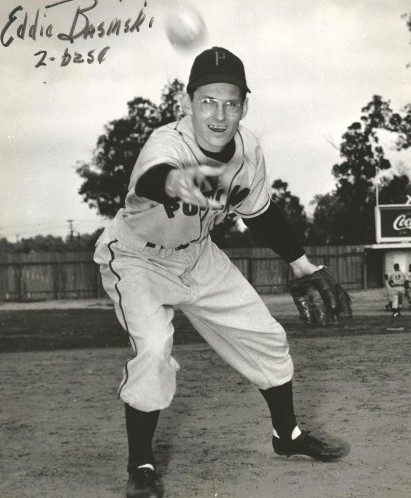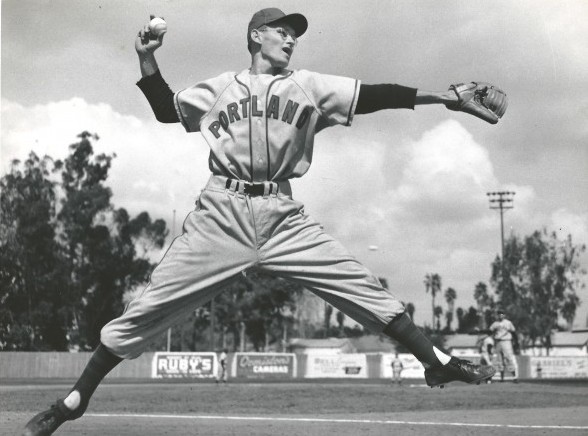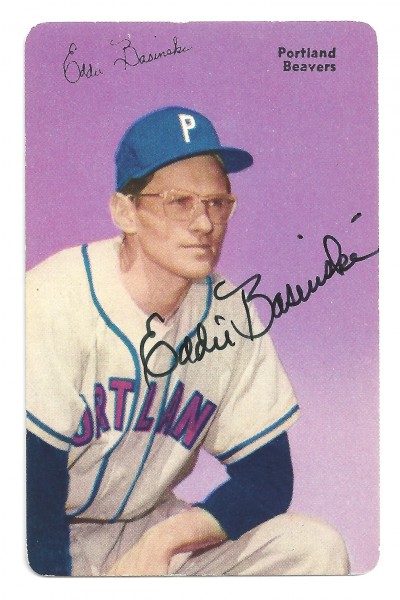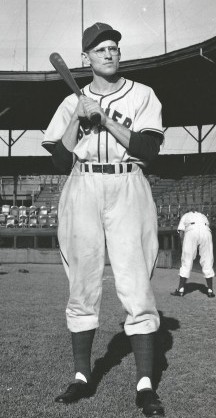
By David Eskenazi and Steve Rudman
Eddie Basinski always conceded that he never looked much like a baseball player. He sported a slender frame and bottle-thick, steel-rimmed classes, prompting many fans to view him as a Mr. Peepers in flannels and Brooklyn Dodgers president and general manager Branch Rickey to describe him as “the escaped divinity student.”
“Inside, I had the same competitive fire that Michael Jordan, Lou Gehrig and Joe DiMaggio had,” Basinski once told an interviewer. “I just didn’t look the part, and people didn’t like it.”
But they loved the view when Eddie Basinski played baseball. Although he didn’t get much of a shot at the major leagues – he played in 203 games with the Dodgers and Pittsburgh Pirates in 1944-45 and part of 1947 – he was a minor league legend good enough to make the Pacific Coast League Hall of Fame, an accolade he earned mainly because of his slick fielding, that the result of his remarkably quick reflexes.

Apart from Basinski’s scholarly, if not dweebish, appearance, the other thing that stamped him as a baseball odd duck was that he came to the game as a trained classical – started at age five — violinist who occupied a chair in the Buffalo Symphony Orchestra, thus his nickname, “The Fiddler.”
As a college freshman, Eddie played in the last chair. By his junior year, he had challenged and outplayed 40 other violinists to become a concert master.
For all of his natural musical talent (he was also a near virtuoso on the piano), Eddie didn’t have much when it came to baseball. But he practiced baseball fundamentals as religiously as he practiced the violin, the main reason he ultimately carved a 16-year professional career, most of it with the Portland Beavers, some of it with the Seattle Rainiers.
Born Nov. 22, 1922 into a large working-class Polish family in Buffalo, NY., Edwin Frank Basinski had a tough father, a former Navy man who ran his house like a military encampment. Eddie’s father believed that if Eddie was going to make anything of himself in life he needed an honest trade.
Eddie’s father considered baseball a frivolous waste of time that had no place in his son’s development. Eddie thought otherwise, but had to sneak out of the house just to play and risked a whipping if his father found out.
Through considerable cajoling, Eddie ultimately received his father’s permission to try out for his high school baseball team, but failed to earn a spot because the school’s coach, Pop Yerke, couldn’t conceive of a skinny, bespectacled kid such as Eddie Basinski playing ball, practically deeming Eddie the before picture in a Charles Atlas advertisement.
So Eddie took to the Buffalo sandlots, playing and practicing with a small core of players that included future Hall of Famer Warren Spahn, one of Eddie’s best childhood friends.
“The city park was next to the street I lived on,” Eddie told author Craig Allen Cleve, who wrote Hardball On The Home Front: Major League Replacement Players of World War II. “There were five aspiring baseball hopefuls who practiced every day there. We rotated our practices so that each player got 30 swings of batting practice. We were able to complete the rotation three times before it got dark.”

If no one else showed at the park, Eddie still had his own training routine. He practiced base running and sliding and even stood a bat on end in front of the backstop, and then went into the outfield to practice making throws at the plate.
“I had something going for me in baseball,” Eddie continued. “I was quick on my feet. I could leap. I had long arms. I thought this is it for me. There isn’t any other way. For me, it was trying to find some way to gain some sort of recognition, so I wasn’t just one of those Polish punks over there from Kaiser town in Buffalo. None of us were going anywhere. Sports was the only avenue I had at that time.”
Eddie didn’t play baseball at the University of Buffalo, either, because the school, although it had an excellent engineering program, had no baseball team. So Eddie lettered in tennis and cross-country and continued to practice baseball, hoping to one day play in one of Buffalo’s semipro AA leagues.
In 1943, Eddie earned a degree in mechanical engineering and went to work for the Curtiss-Wright Company in Buffalo, one of the country’s leading aircraft manufacturers and a primary producer of U.S. warplanes, including the P-40 Warhawk, the P-47 Thunderbolt and the C-46 cargo plane.
Also in 1943, Eddie finally broke into Buffalo’s AA league, playing shortstop and batting cleanup, and people began to take notice of his superb fielding and timely hitting. Dick Fisher, who owned a Buffalo sporting goods store and bird dogged the city’s sandlots for major league teams, lobbied on Eddie’s behalf.
At the end of 1943, an all-star team composed of Buffalo’s best AA players, Eddie included, assembled to play similar teams in New York and Pennsylvania. One such outfit from Oil City, PA., boasted a 19-game winning streak. Fisher convinced Branch Rickey to send a scout to the Buffalo-Oil City game.

Buffalo hammered Oil City 9-1 with Eddie delivering a two-run triple and pair of three-run homers, accounting for eight of his team’s nine runs. A perfect performance under perfect circumstances resulted in the Dodgers signing Eddie to a contract that included a $5,000 signing bonus.
Eddie joined the Dodgers in early 1944 for two weeks so that the club could take a look at him and figure out at which minor league level he ought to play. At the end of the two weeks, with the Dodgers at Crosley Field in Cincinnati, manager Leo Durocher called on Eddie to bat eighth and play second base.
The date: May 20, 1944. Eddie had not played baseball in either high school or college and had only one limited season in Buffalo’s AA leagues. After he stepped in against Reds left hander Clyde Shoun, who threw a no-hitter a week earlier against the Boston Braves, Ripley’s Believe It Or Not called his jump from semipro ball to the majors “a 10 million to one shot.”

Eddie looked at Shon’s first pitch and drilled the second one off the wall in left for a triple. After he nailed a runner at first by 10 feet, and turned five double plays in seven chances, Durocher began calling him “Bazooka” (the Dodgers turned only four double plays in their previous 20 games).
By the first of June, Eddie was hitting better than .300 and making both Durocher and Rickey look like the smartest men in the history of baseball. Whenever Eddie made a key play in the infield, announcer Red Barber would enthuse, “The violin is playing sweetly today!”
Basinski’s teammates ribbed him mercilessly about playing the violin, one reason that Eddie never brought his prized violin to the Dodgers’ Ebbets Field clubhouse. In fact, Durocher grew skeptical that he could actually play. So Eddie made Durocher a bet: He would play the violin in front of Leo and anybody else Leo wanted. If they like what they heard, Leo would pay Eddie $1,000. Durocher thought that over and accepted.
A few weeks later, Eddie showed up in the clubhouse and played selections from Cole Porter, Irving Berlin and Victor Herbert. He also threw in a Strauss waltz.
“Well, I’ll be a son of a bitch. The kid can play,” marveled Durocher.
“A lot of people think musicians are pantywaists,” Eddie said. “That’s a bunch of” nonsense.
Unfortunately for Eddie, he couldn’t sustain his hot hitting and finished the season at AA Montreal, where he hit .244. He played 108 games in 1945, hitting .262 as he replacement for Pee Wee Reese (serving in the military that year) and made the National League All-Star team.

Then Eddie went to Pittsburgh in a Dec. 5, 1946 trade for Al Gerheauser. After Eddie hit only .199 in 56 games for the Pirates, his major league career came to an end and his PCL career began at 24 after the New York Yankees, who had acquired him in a trade, sent him to the Portland Beavers.
“When I got out here (Pacific Northwest) I was floored by the beauty,” Basinski told The Oregonian. “And the people were just great. Buffalo neighborhoods were divided among ethnic groups, and gangs guarded their turf. Somebody who didn’t belong there was beaten up. Back there you’d introduce yourself and . . . they’d immediately categorize you. That didn’t happen in Portland. It finally dawned on me, and I said, `Hey, this is America!’ ”
Eddie spent slightly more than 10 seasons with the Beavers, hitting between .240 and .277 while annually ranking among the top defensive players in the league. In 1950, Basinski played in every inning of the 202-game Pacific Coast League schedule.
He became a fan favorite — in 1955, in a newspaper poll to name Portland’s all-time team, Basinski got more votes than anybody. That probably figured, given that Eddie often trotted out his violin and performed home-plate recitals on Sundays between games of doubleheaders.
“One time I got a tremendous ovation, and had a good doubleheader, too,” he said.
On May 23, 1956, Basinski uncharacteristically committed three errors in the second inning against the Hollywood Stars, and the Beavers trailed 5-0. But Basinski hit a grand slam in the bottom of the ninth to win it, 6-5.
A newspaper account read: “The very first pitch to the violin-playing infielder was met with a vicious crack of the bat and was parked over the left-field fence at the 340-foot mark. The game was over. In one second, the villain became the hero.”

Basinski figured that he would end his career with the Beavers. But on April 25, 1957, the Beavers waived the 31-year-old in a cost-cutting move, leaving him available for any team willing to pay the waiver price. The Rainiers acted swiftly, largely to add to their infield depth and also because of Eddie’s ability as a clutch hitter. When Eddie left Portland, he had played in 557 consecutive games and couldn’t understand his release.
“I was shocked when Portland waivered me out,” Basinski told The Oregonian. “I’ll never understand why the club let me go. I had the second-best spring training of my life.”
Basinski’s most notable series for the Rainiers came when they faced the Beavers for the first time in an early-season, seven-game series. Basinski went 7-for-14, while missing four of the seven contests with an eye injury.
Basinski played in 136 games for the 1957 Rainiers, who went 87-80 under Lefty O’Doul, in his last year of managing. He hit .271 with a .712 OPS and often helped rookie Maury Wills with infield fundamentals.
Eddie posted a good year in 1958 when he hit .301 with 46 RBIs (Basinski hit the first double of the season, winning 13 car washes from a Rainiers sponsor), but the Rainiers, even with 19-year-old sensation Vada Pinson hitting .343 in 124 games, flailed under manager Connie Ryan, finishing 68-86, at one point losing 14 consecutive games, just three shy of Sacramento’s 1925 league record of 17.
Despite Eddie’s numbers, the Rainiers figured that he didn’t have much left and sold him to Vancouver. In fact, he didn’t have much left. Basinski played in just 43 games and hit .138 for the 1959 Mounties.
During his PCL career, Basinski compiled 1,426 hits, 99 homers and 579 RBIs, all while batting .259. He led the PCL in games played in 1950 and at-bats in 1951.
Basinski, who settled in Oregon once his playing career ended, took up bowling and golf in retirement. He had the honor of being inducted into the Oregon Sports Hall of Fame in 1987, the Brooklyn Dodgers Hall of Fame in 1996 and the Pacific Coast League Hall of Fame in 2006.
————————————–
Many of the historic images published on Sportspress Northwest are provided by resident Northwest sports history aficionado David Eskenazi. Check out Davids Wayback Machine Archive. David can be reached at (206) 441-1900, or at seattlesportshistory@gmail.com
